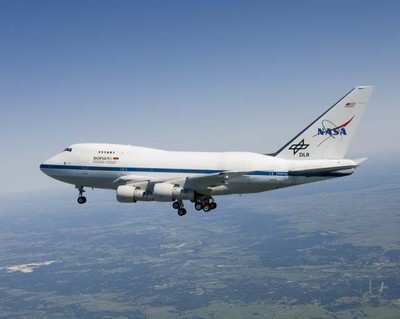Modified Boeing 747SP Houses 17-Metric-Ton Telescope
NASA's Stratospheric Observatory for Infrared Astronomy, or
SOFIA, has begun a series of flight tests intended to confirm the
structural integrity and performance of the highly modified Boeing
747SP aircraft.

The current tests, which began Thursday, are the first of
several flight and ground-test phases required to verify that the
unique airborne observatory is ready to perform its future
astronomical science mission. Thursday's flight lasted just over
five hours and was conducted by NASA's Dryden Flight Research
Center in restricted test airspace northwest of Edwards Air Force
Base in Southern California.
"The flight went very smoothly overall, and we accomplished (the
test points) that I expected," said NASA research pilot Frank
Batteas, pilot-in-command for Thursday's test mission. "The
aircraft will be a very stable platform for its observatory
mission."
A 17-metric-ton telescope was installed in SOFIA's aft fuselage
during major modifications at L-3 Communications Integrated Systems
facility in Waco, TX. A 16-foot-high telescope cavity door opening
was cut into the fuselage during the installation process.
The first series of flight tests, conducted with the cavity door
closed, are studying the aerodynamics, structural integrity,
stability and control and handling qualities of the modified
aircraft, according to NASA Dryden's SOFIA aircraft project manager
John Carter. Later flights in the series will concentrate on the
in-flight free-floating rotational motion and control of the
German-built telescope.
Since its arrival at Dryden, the aircraft has been outfitted
with test instrumentation critical for the initial series of flight
tests. The aircraft has also been equipped with a telescope cavity
environmental control system designed to keep the telescope dry
when the door is closed and as the aircraft flies to the altitude
required for operation of the observatory.
After door-closed flight testing is complete -- expected by
year-end -- the SOFIA 747 will undergo installation and integration
of the remaining elements of the observatory before door-open test
flights, scheduled to begin in late 2008.
 "The largest technical challenges
are in 2008, with the remainder of the mission sub-system
installation that will give the aircraft the ability to fly with
the cavity door open," Carter said.
"The largest technical challenges
are in 2008, with the remainder of the mission sub-system
installation that will give the aircraft the ability to fly with
the cavity door open," Carter said.
When fully operational, SOFIA's 2.5-meter infrared telescope
will conduct celestial observations while flying at up to 45,000
feet altitude. This will place the instrument above almost 99
percent of the Earth's atmospheric water vapor, greatly enhancing
its abilities to probe into space. The flying observatory is
designed to detect the formation of stars in our galaxy, determine
the chemical composition of the interstellar medium, and peer
through the dust that hides the black hole at the center of the
Milky Way.
After completing flight testing and further modifications, NASA
plans to begin "first light" infrared observations of the universe
in 2009.
This will enable the mission to begin obtaining results several
years before the observatory reaches its full capacity in 2014.
SOFIA will collect science data using a variety of specialized
instruments developed by NASA and its German partners.
"SOFIA is making tremendous progress towards the initiation of
science observations in 2009, and the initiation of flight testing
is another milestone along the path to science observations," said
Jon Morse, director of the Astrophysics Division in the Science
Mission Directorate at NASA Headquarters, Washington. "Early
observations will have significant science community involvement in
order to initiate broad scientific use of this unique astronomical
observatory."

The SOFIA program is a partnership of NASA and the German
Aerospace Center. NASA Dryden manages the SOFIA program, with
science elements of the program managed by the NASA Ames Research
Center, Moffett Field, CA.
 ANN's Daily Aero-Term (04.14.24): Maximum Authorized Altitude
ANN's Daily Aero-Term (04.14.24): Maximum Authorized Altitude ANN's Daily Aero-Linx (04.14.24)
ANN's Daily Aero-Linx (04.14.24) Classic Aero-TV: 'We're Surviving'-- Kyle Franklin Describes Airshow Life 2013
Classic Aero-TV: 'We're Surviving'-- Kyle Franklin Describes Airshow Life 2013 Aero-News: Quote of the Day (04.14.24)
Aero-News: Quote of the Day (04.14.24) Airborne 04.09.24: SnF24!, Piper-DeltaHawk!, Fisher Update, Junkers
Airborne 04.09.24: SnF24!, Piper-DeltaHawk!, Fisher Update, Junkers





